Ryzhkov/iStock/GettyImages
A steakhouse roast, more commonly known as a strip loin roast, is taken from the tenderloin; this boneless cut is particularly well marbled with fat and, cooked properly, can be juicy, tender and flavorful. As the cook, your most important job is to prevent dried-out, tough, chewy meat resulting from overcooking. Cooking time is affected by several variables; while you should have an estimated cooking time in mind, go by the meat's internal temperature to know when it's ready to come out of the oven.
Remove the steakhouse roast from the refrigerator an hour before cooking it so it can come to room temperature. Chilled beef doesn't cook evenly, and the rapid change in temperature from fridge to oven causes the meat fibers to contract and toughen.
Trim excess fat off the strip loin roast with a sharp knife, leaving a layer of 1/4 to 1/2 inch of fat to flavor the meat as it melts during cooking. It's easiest to trim fat while the roast is still chilled.
Arrange the racks in your oven as needed so the steakhouse roast is in the middle of the oven during cooking. Preheat the oven to 450 degrees Fahrenheit.
Season the strip loin roast. The meat has plenty of flavor on it's own, so doesn't really need anything more than a patting of salt and pepper to bring those flavors out. Add a sprinkling of dried thyme or rosemary if you want a bit more depth of flavor.
Line the bottom of a shallow roasting pan with aluminum foil to protect it from burned-on drippings and to keep cleanup simple. Don't use a pan more than 2 inches deep, or you risk partially steaming the steakhouse roast. Put the rack in the pan and center the meat on it.
Put the strip loin roast into the middle of the oven and cook it for 15 minutes, then turn the oven down to 350 degrees F.
Cook the steakhouse roast to at least medium, or an internal temperature of 145 degrees F, as determined with use of a meat thermometer. Remove the meat from the oven once it reaches 140 degrees F; the internal temperature will rise at least another 5 degrees during resting.
Transfer the strip loin roast immediately to a serving tray, but don't start cutting it yet. Rest it for 15 minutes so its juices redistribute and settle rather than running out of the meat when it's cut. It will come to the safe minimum temperature during resting, provided it reached at least 140 degrees F in the oven. Tent it with aluminum foil to keep it warm for the meal.
Related Articles
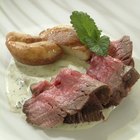
How to Cook a Four-Pound Sirloin Tip ...
How to Cook Brisket Slowly With a ...
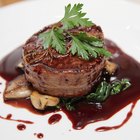
How to Cook Bacon-Wrapped Beef Chuck ...

How to Cook a 15-Pound Rib Roast

How to Cook Angus Beef in the Oven

How to Cook a Beef Topside Roast

How to Convection Roast a Brisket

How to Make a Blackbuck Antelope Roast

How to Cook a Frozen Pork Fillet in the ...
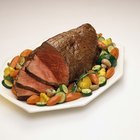
How to Cook a Roast Beef to a Perfect ...
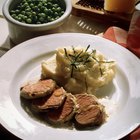
How to Make a Juicy Pork Tenderloin

How to Roast a Pork Blade Cut

Roasting Instructions for a Half Loin ...

Internal Temp of Rare Roast Beef

The Best Way to Prepare Bison Sirloin

How Long Does It Take to Cook a ...
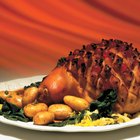
How Do I Cook Boneless Pork Leg Roast ...
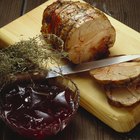
How to Cook a Roast in Advance & Reheat
How to Cook a Center Cut Sirloin of ...

How to Cook a Petite Filet of Beef in ...
References
Tips
- Combine dried thyme and rosemary with a little salt, pepper, garlic and olive oil in the food processor and bring them to a paste-like consistency. This creates a garlic herb crust for the roast; apply it evenly over the beef with a cooking brush.
- Avoid sticking a fork into the steakhouse roast when handling it, or its juices will escape through the holes during cooking. Instead, use cooking tongs to move the meat around.
Warnings
- Cooking time and the color of the meat aren't reliable ways to determine doneness; always confirm the meat's internal temperature has reached the minimum required temperature by inserting a meat thermometer into the middle of the thickest part of the cut.
Writer Bio
Eric Mohrman is a food and drink, travel, and lifestyle writer living in Orlando, Florida. He has professional experience to complement his love of cooking and eating, having worked for 10 years both front- and back-of-house in casual and fine dining restaurants. He has written print and web pieces on food and drink topics for Visit Florida, Orlando Style Magazine, CrushBrew Magazine, Agent Magazine, Dollar Stretcher Magazine, The 863 Magazine and other publications.